AFB Exam: Income Statement, Financial Position, Investment Analysis, Ratios and Performance Evaluation
VerifiedAdded on 2023/06/10
|11
|1614
|457
AI Summary
This AFB exam includes income statement and financial position for ST plc, investment analysis with payback period and net present value, non-financial factors affecting investment decisions, internal rate of return and its advantages, and ratio analysis with performance evaluation of NS plc.
Contribute Materials
Your contribution can guide someone’s learning journey. Share your
documents today.
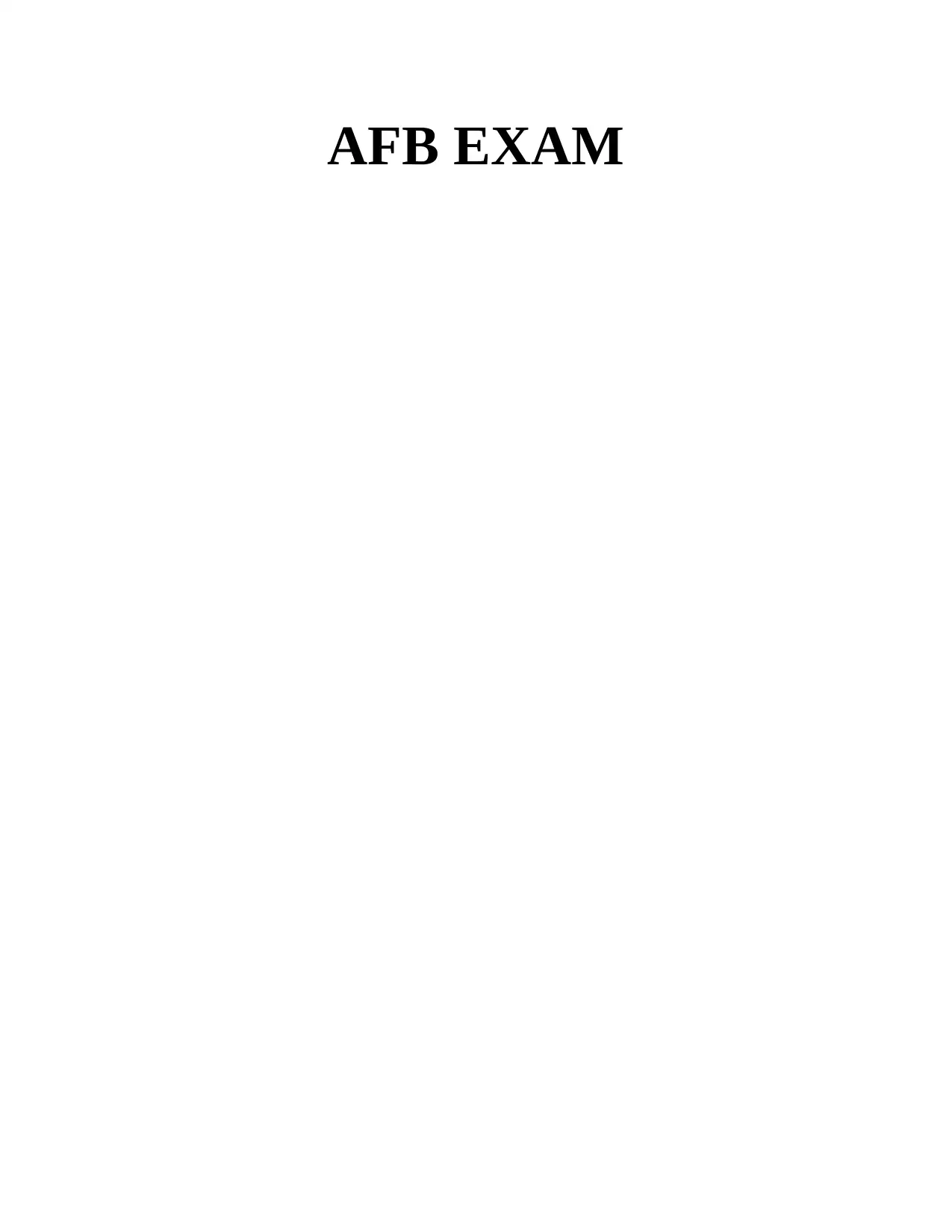
AFB EXAM
Secure Best Marks with AI Grader
Need help grading? Try our AI Grader for instant feedback on your assignments.
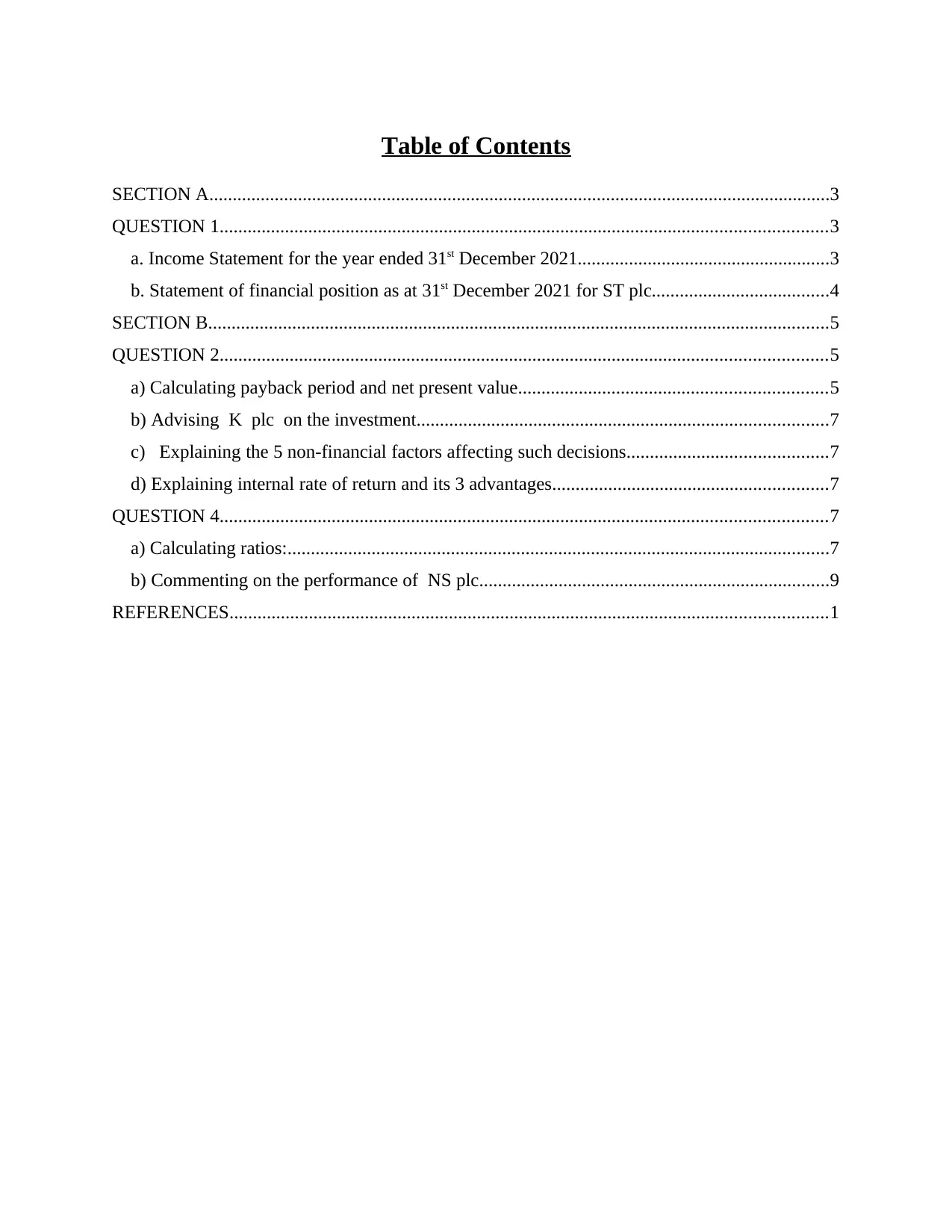
Table of Contents
SECTION A.....................................................................................................................................3
QUESTION 1..................................................................................................................................3
a. Income Statement for the year ended 31st December 2021......................................................3
b. Statement of financial position as at 31st December 2021 for ST plc......................................4
SECTION B.....................................................................................................................................5
QUESTION 2..................................................................................................................................5
a) Calculating payback period and net present value..................................................................5
b) Advising K plc on the investment........................................................................................7
c) Explaining the 5 non-financial factors affecting such decisions...........................................7
d) Explaining internal rate of return and its 3 advantages...........................................................7
QUESTION 4..................................................................................................................................7
a) Calculating ratios:....................................................................................................................7
b) Commenting on the performance of NS plc...........................................................................9
REFERENCES................................................................................................................................1
SECTION A.....................................................................................................................................3
QUESTION 1..................................................................................................................................3
a. Income Statement for the year ended 31st December 2021......................................................3
b. Statement of financial position as at 31st December 2021 for ST plc......................................4
SECTION B.....................................................................................................................................5
QUESTION 2..................................................................................................................................5
a) Calculating payback period and net present value..................................................................5
b) Advising K plc on the investment........................................................................................7
c) Explaining the 5 non-financial factors affecting such decisions...........................................7
d) Explaining internal rate of return and its 3 advantages...........................................................7
QUESTION 4..................................................................................................................................7
a) Calculating ratios:....................................................................................................................7
b) Commenting on the performance of NS plc...........................................................................9
REFERENCES................................................................................................................................1
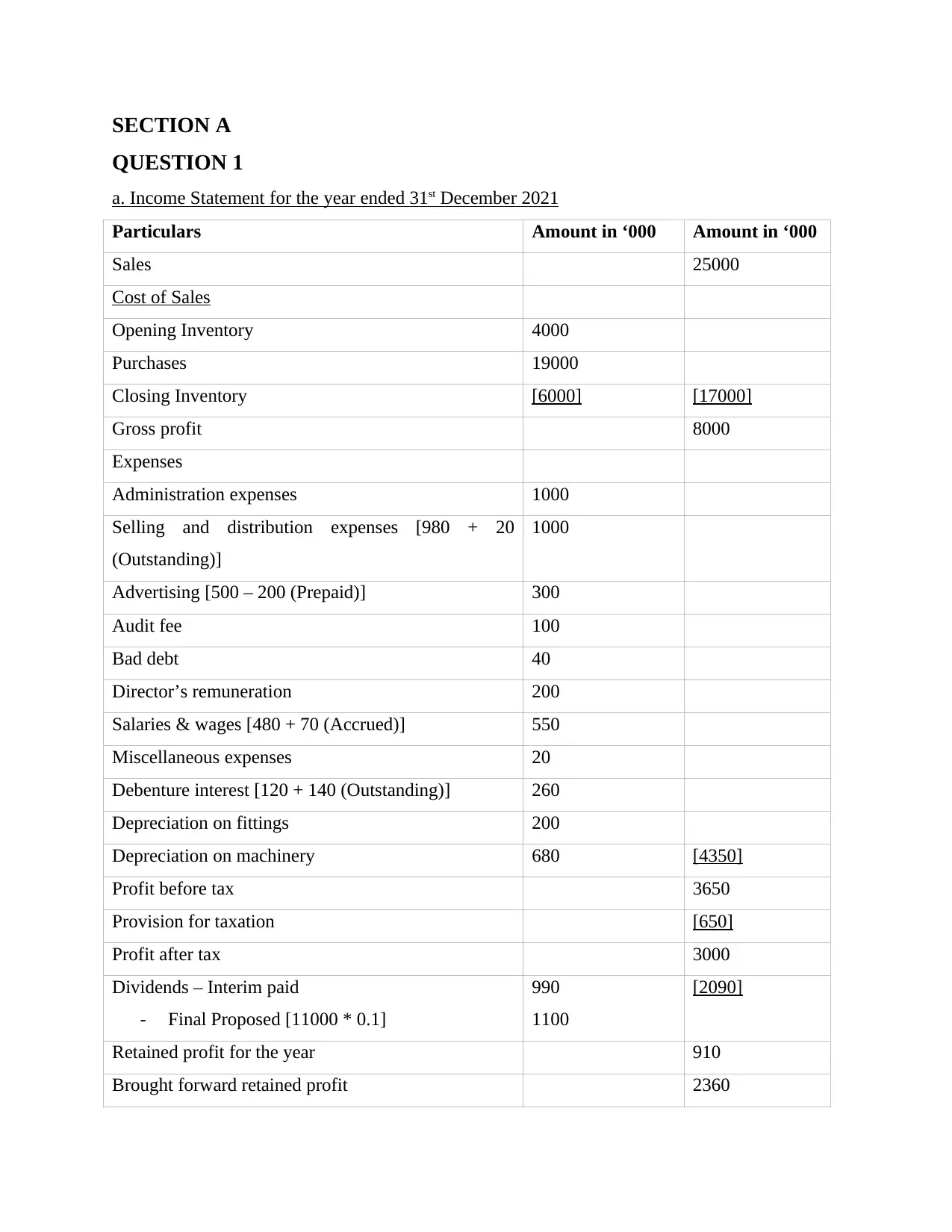
SECTION A
QUESTION 1
a. Income Statement for the year ended 31st December 2021
Particulars Amount in ‘000 Amount in ‘000
Sales 25000
Cost of Sales
Opening Inventory 4000
Purchases 19000
Closing Inventory [6000] [17000]
Gross profit 8000
Expenses
Administration expenses 1000
Selling and distribution expenses [980 + 20
(Outstanding)]
1000
Advertising [500 – 200 (Prepaid)] 300
Audit fee 100
Bad debt 40
Director’s remuneration 200
Salaries & wages [480 + 70 (Accrued)] 550
Miscellaneous expenses 20
Debenture interest [120 + 140 (Outstanding)] 260
Depreciation on fittings 200
Depreciation on machinery 680 [4350]
Profit before tax 3650
Provision for taxation [650]
Profit after tax 3000
Dividends – Interim paid
- Final Proposed [11000 * 0.1]
990
1100
[2090]
Retained profit for the year 910
Brought forward retained profit 2360
QUESTION 1
a. Income Statement for the year ended 31st December 2021
Particulars Amount in ‘000 Amount in ‘000
Sales 25000
Cost of Sales
Opening Inventory 4000
Purchases 19000
Closing Inventory [6000] [17000]
Gross profit 8000
Expenses
Administration expenses 1000
Selling and distribution expenses [980 + 20
(Outstanding)]
1000
Advertising [500 – 200 (Prepaid)] 300
Audit fee 100
Bad debt 40
Director’s remuneration 200
Salaries & wages [480 + 70 (Accrued)] 550
Miscellaneous expenses 20
Debenture interest [120 + 140 (Outstanding)] 260
Depreciation on fittings 200
Depreciation on machinery 680 [4350]
Profit before tax 3650
Provision for taxation [650]
Profit after tax 3000
Dividends – Interim paid
- Final Proposed [11000 * 0.1]
990
1100
[2090]
Retained profit for the year 910
Brought forward retained profit 2360
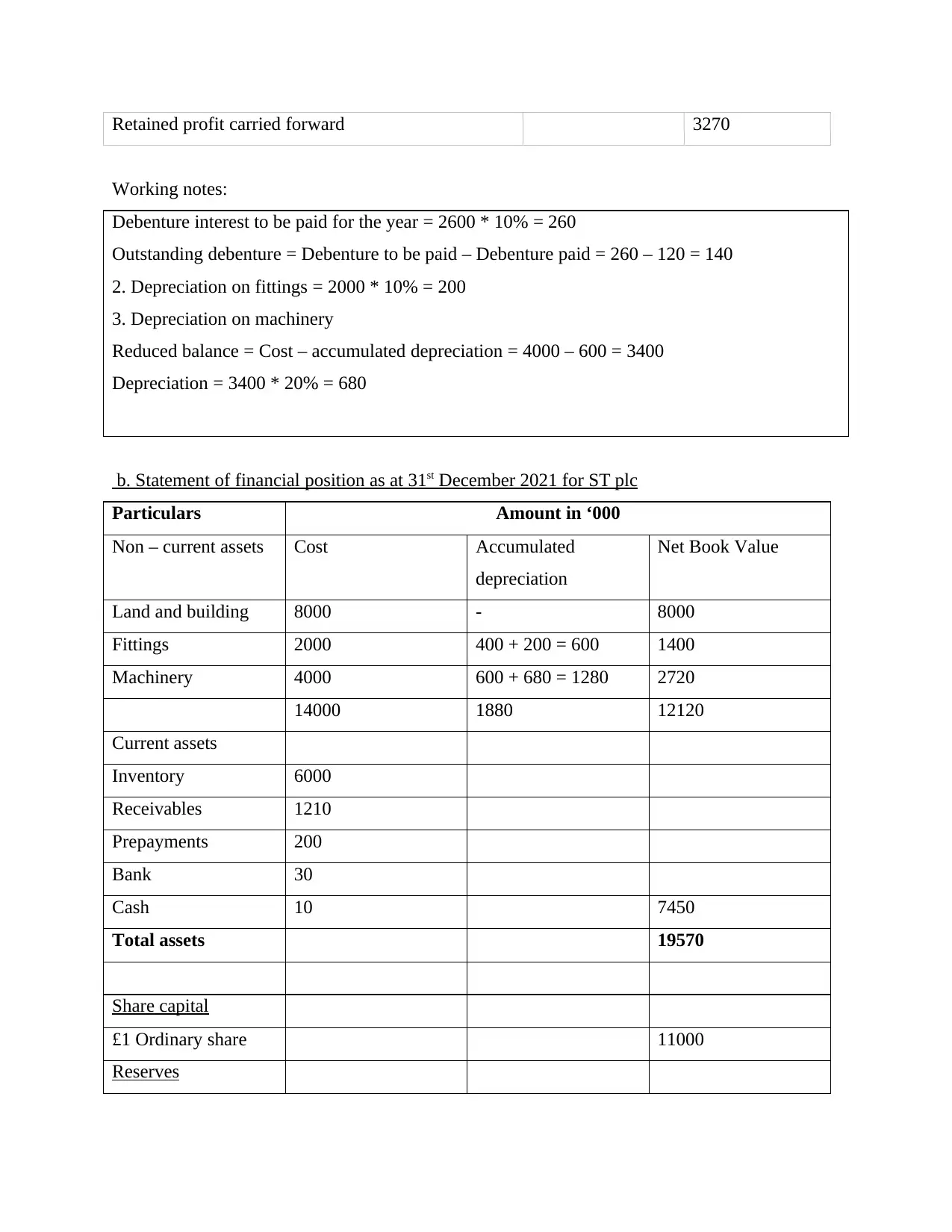
Retained profit carried forward 3270
Working notes:
Debenture interest to be paid for the year = 2600 * 10% = 260
Outstanding debenture = Debenture to be paid – Debenture paid = 260 – 120 = 140
2. Depreciation on fittings = 2000 * 10% = 200
3. Depreciation on machinery
Reduced balance = Cost – accumulated depreciation = 4000 – 600 = 3400
Depreciation = 3400 * 20% = 680
b. Statement of financial position as at 31st December 2021 for ST plc
Particulars Amount in ‘000
Non – current assets Cost Accumulated
depreciation
Net Book Value
Land and building 8000 - 8000
Fittings 2000 400 + 200 = 600 1400
Machinery 4000 600 + 680 = 1280 2720
14000 1880 12120
Current assets
Inventory 6000
Receivables 1210
Prepayments 200
Bank 30
Cash 10 7450
Total assets 19570
Share capital
£1 Ordinary share 11000
Reserves
Working notes:
Debenture interest to be paid for the year = 2600 * 10% = 260
Outstanding debenture = Debenture to be paid – Debenture paid = 260 – 120 = 140
2. Depreciation on fittings = 2000 * 10% = 200
3. Depreciation on machinery
Reduced balance = Cost – accumulated depreciation = 4000 – 600 = 3400
Depreciation = 3400 * 20% = 680
b. Statement of financial position as at 31st December 2021 for ST plc
Particulars Amount in ‘000
Non – current assets Cost Accumulated
depreciation
Net Book Value
Land and building 8000 - 8000
Fittings 2000 400 + 200 = 600 1400
Machinery 4000 600 + 680 = 1280 2720
14000 1880 12120
Current assets
Inventory 6000
Receivables 1210
Prepayments 200
Bank 30
Cash 10 7450
Total assets 19570
Share capital
£1 Ordinary share 11000
Reserves
Secure Best Marks with AI Grader
Need help grading? Try our AI Grader for instant feedback on your assignments.

Retained Profit 3270
Shareholder’s Fund
[or Equity]
14270
Non – Current
liability
10% Debenture 2600
Current liabilities
Accruals [20 + 70 +
140]
230
Provision for taxation 650
Proposed dividends 1100
Payables 720 2700
Shareholder funds
and liabilities
19570
SECTION B
QUESTION 2
a) Calculating payback period and net present value
Net cash inflows:
year
cash
inflows
(in
£000s) depreciation EBIT
net cash
inflow
(in
£000s)
1 600 100000 -99400 600
2 700 100000 -99300 700
3 800 100000 -99200 800
4 600 100000 -99400 600
5 400 100000 -99600 400
Net present value:
Shareholder’s Fund
[or Equity]
14270
Non – Current
liability
10% Debenture 2600
Current liabilities
Accruals [20 + 70 +
140]
230
Provision for taxation 650
Proposed dividends 1100
Payables 720 2700
Shareholder funds
and liabilities
19570
SECTION B
QUESTION 2
a) Calculating payback period and net present value
Net cash inflows:
year
cash
inflows
(in
£000s) depreciation EBIT
net cash
inflow
(in
£000s)
1 600 100000 -99400 600
2 700 100000 -99300 700
3 800 100000 -99200 800
4 600 100000 -99400 600
5 400 100000 -99600 400
Net present value:
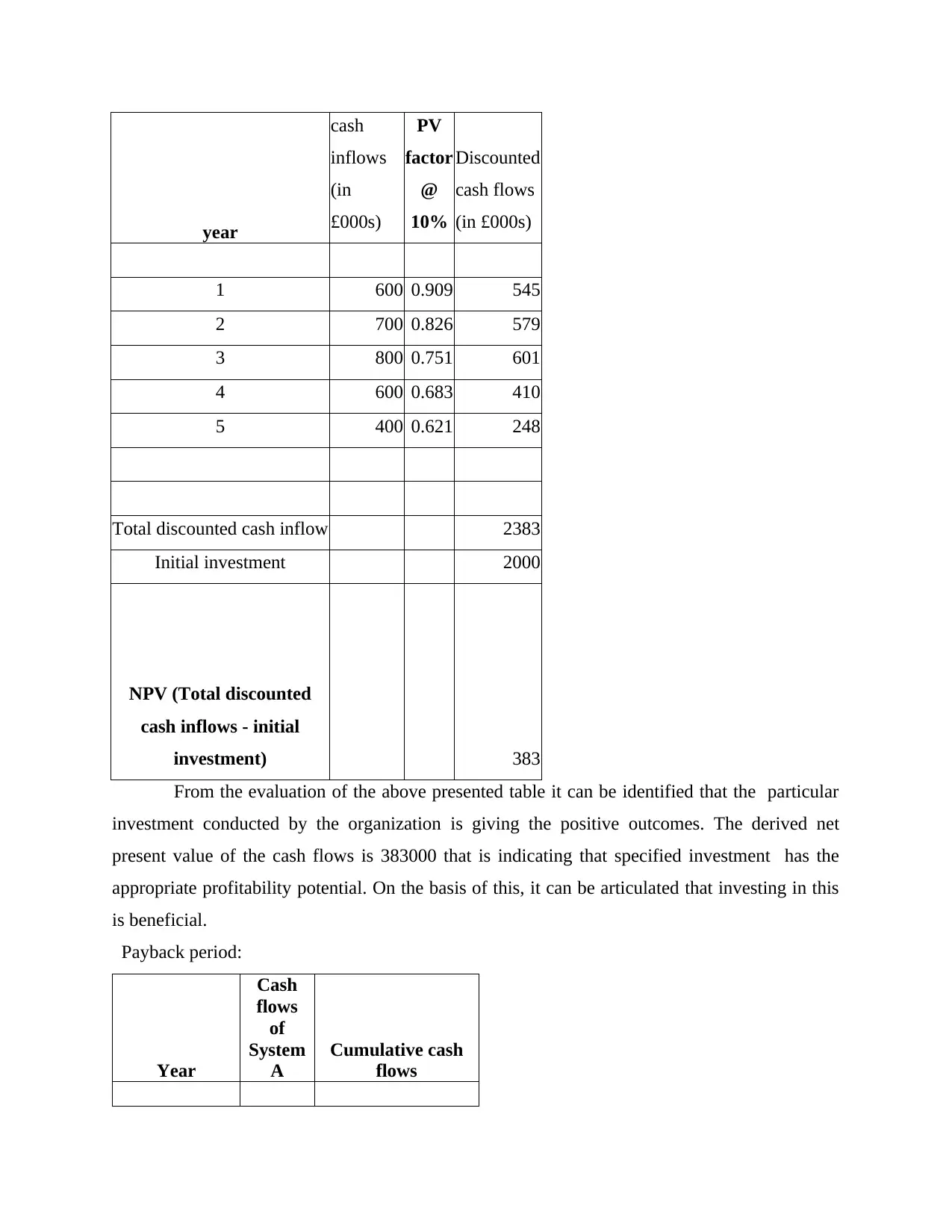
year
cash
inflows
(in
£000s)
PV
factor
@
10%
Discounted
cash flows
(in £000s)
1 600 0.909 545
2 700 0.826 579
3 800 0.751 601
4 600 0.683 410
5 400 0.621 248
Total discounted cash inflow 2383
Initial investment 2000
NPV (Total discounted
cash inflows - initial
investment) 383
From the evaluation of the above presented table it can be identified that the particular
investment conducted by the organization is giving the positive outcomes. The derived net
present value of the cash flows is 383000 that is indicating that specified investment has the
appropriate profitability potential. On the basis of this, it can be articulated that investing in this
is beneficial.
Payback period:
Year
Cash
flows
of
System
A
Cumulative cash
flows
cash
inflows
(in
£000s)
PV
factor
@
10%
Discounted
cash flows
(in £000s)
1 600 0.909 545
2 700 0.826 579
3 800 0.751 601
4 600 0.683 410
5 400 0.621 248
Total discounted cash inflow 2383
Initial investment 2000
NPV (Total discounted
cash inflows - initial
investment) 383
From the evaluation of the above presented table it can be identified that the particular
investment conducted by the organization is giving the positive outcomes. The derived net
present value of the cash flows is 383000 that is indicating that specified investment has the
appropriate profitability potential. On the basis of this, it can be articulated that investing in this
is beneficial.
Payback period:
Year
Cash
flows
of
System
A
Cumulative cash
flows
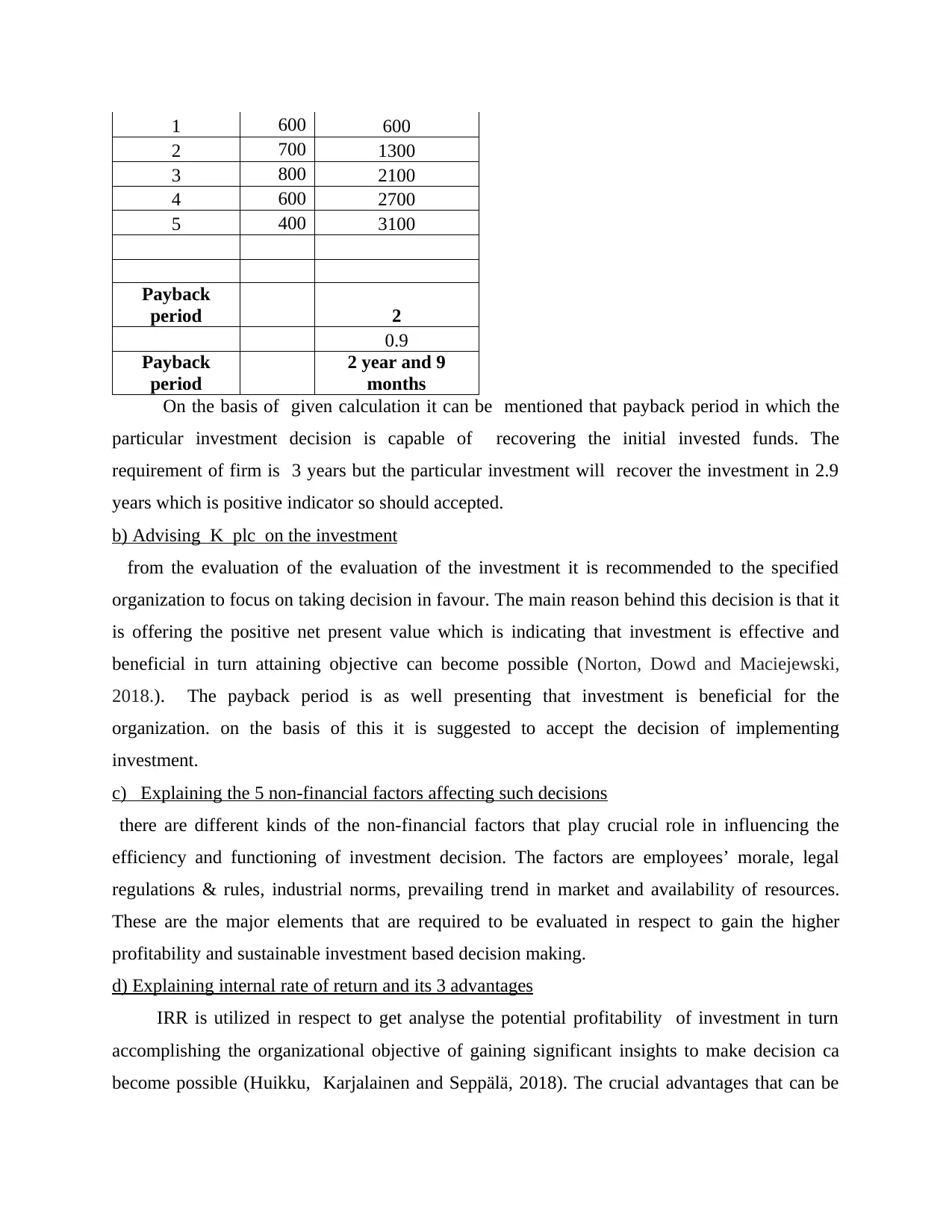
1 600 600
2 700 1300
3 800 2100
4 600 2700
5 400 3100
Payback
period 2
0.9
Payback
period
2 year and 9
months
On the basis of given calculation it can be mentioned that payback period in which the
particular investment decision is capable of recovering the initial invested funds. The
requirement of firm is 3 years but the particular investment will recover the investment in 2.9
years which is positive indicator so should accepted.
b) Advising K plc on the investment
from the evaluation of the evaluation of the investment it is recommended to the specified
organization to focus on taking decision in favour. The main reason behind this decision is that it
is offering the positive net present value which is indicating that investment is effective and
beneficial in turn attaining objective can become possible (Norton, Dowd and Maciejewski,
2018.). The payback period is as well presenting that investment is beneficial for the
organization. on the basis of this it is suggested to accept the decision of implementing
investment.
c) Explaining the 5 non-financial factors affecting such decisions
there are different kinds of the non-financial factors that play crucial role in influencing the
efficiency and functioning of investment decision. The factors are employees’ morale, legal
regulations & rules, industrial norms, prevailing trend in market and availability of resources.
These are the major elements that are required to be evaluated in respect to gain the higher
profitability and sustainable investment based decision making.
d) Explaining internal rate of return and its 3 advantages
IRR is utilized in respect to get analyse the potential profitability of investment in turn
accomplishing the organizational objective of gaining significant insights to make decision ca
become possible (Huikku, Karjalainen and Seppälä, 2018). The crucial advantages that can be
2 700 1300
3 800 2100
4 600 2700
5 400 3100
Payback
period 2
0.9
Payback
period
2 year and 9
months
On the basis of given calculation it can be mentioned that payback period in which the
particular investment decision is capable of recovering the initial invested funds. The
requirement of firm is 3 years but the particular investment will recover the investment in 2.9
years which is positive indicator so should accepted.
b) Advising K plc on the investment
from the evaluation of the evaluation of the investment it is recommended to the specified
organization to focus on taking decision in favour. The main reason behind this decision is that it
is offering the positive net present value which is indicating that investment is effective and
beneficial in turn attaining objective can become possible (Norton, Dowd and Maciejewski,
2018.). The payback period is as well presenting that investment is beneficial for the
organization. on the basis of this it is suggested to accept the decision of implementing
investment.
c) Explaining the 5 non-financial factors affecting such decisions
there are different kinds of the non-financial factors that play crucial role in influencing the
efficiency and functioning of investment decision. The factors are employees’ morale, legal
regulations & rules, industrial norms, prevailing trend in market and availability of resources.
These are the major elements that are required to be evaluated in respect to gain the higher
profitability and sustainable investment based decision making.
d) Explaining internal rate of return and its 3 advantages
IRR is utilized in respect to get analyse the potential profitability of investment in turn
accomplishing the organizational objective of gaining significant insights to make decision ca
become possible (Huikku, Karjalainen and Seppälä, 2018). The crucial advantages that can be
Paraphrase This Document
Need a fresh take? Get an instant paraphrase of this document with our AI Paraphraser

obtained by using this particular method o investment appraisal involves calculating by using
time value of money, simple to interpret and making significant decision by having estimated
arte of return. These allows to get the significant availability to accomplish the organizational
objective in turn greater competitiveness can be derived.
QUESTION 4
a) Calculating ratios:
Particulars Formula 2021
Net profit 120.8
Sales
revenue 830.4
NP ratio
Net
profit /
sales *
100 15%
Particulars Formula 2021
Current
assets 419.5
Current
liabilities 346.2
Current
ratio
Current
assets /
current
liabilities 1.211727
Particulars Formula 2021
Particulars Formula 2021
Gross
Profit 184.2
Sales
revenue 830.4
GP ratio
Gross
profit /
sales *
100 22%
time value of money, simple to interpret and making significant decision by having estimated
arte of return. These allows to get the significant availability to accomplish the organizational
objective in turn greater competitiveness can be derived.
QUESTION 4
a) Calculating ratios:
Particulars Formula 2021
Net profit 120.8
Sales
revenue 830.4
NP ratio
Net
profit /
sales *
100 15%
Particulars Formula 2021
Current
assets 419.5
Current
liabilities 346.2
Current
ratio
Current
assets /
current
liabilities 1.211727
Particulars Formula 2021
Particulars Formula 2021
Gross
Profit 184.2
Sales
revenue 830.4
GP ratio
Gross
profit /
sales *
100 22%
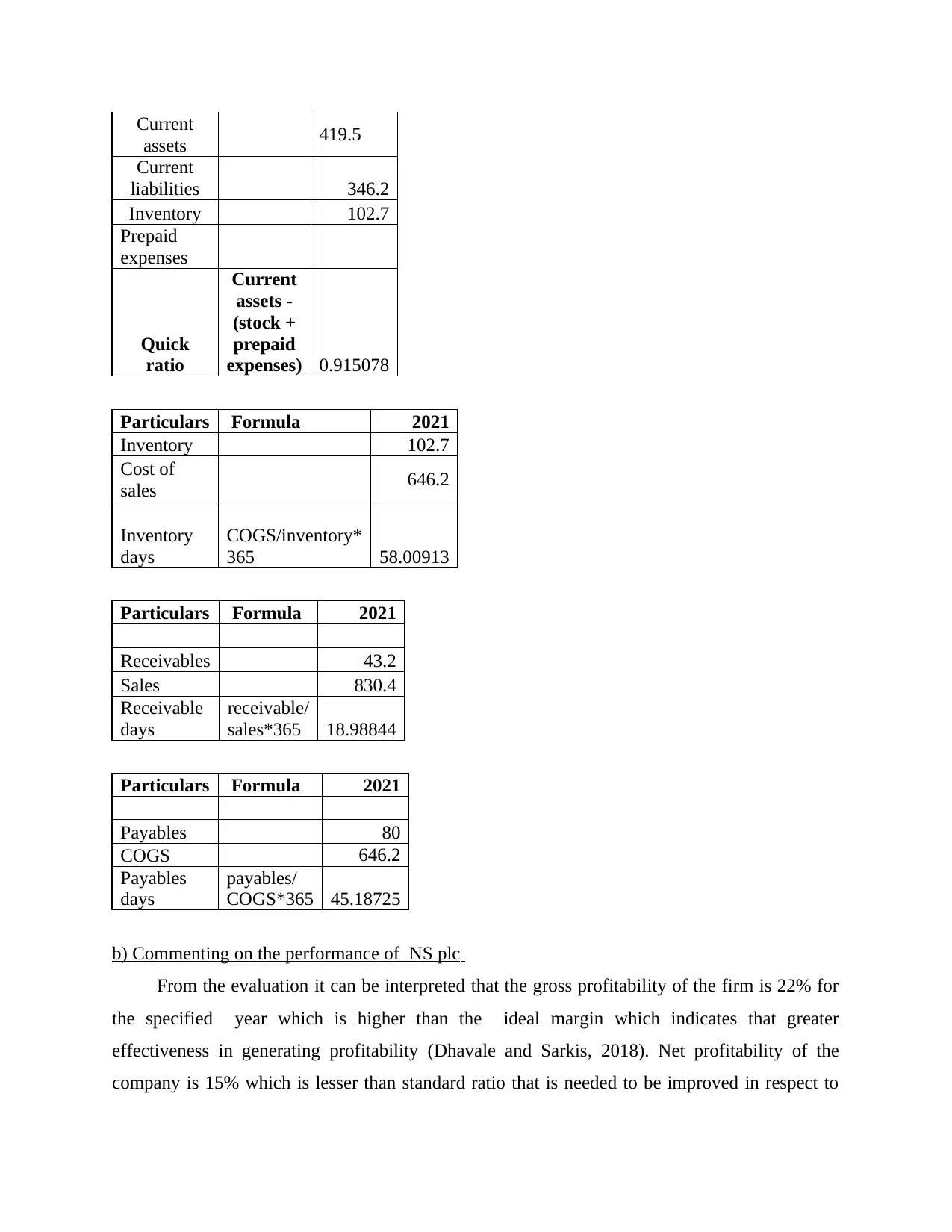
Current
assets 419.5
Current
liabilities 346.2
Inventory 102.7
Prepaid
expenses
Quick
ratio
Current
assets -
(stock +
prepaid
expenses) 0.915078
Particulars Formula 2021
Inventory 102.7
Cost of
sales 646.2
Inventory
days
COGS/inventory*
365 58.00913
Particulars Formula 2021
Receivables 43.2
Sales 830.4
Receivable
days
receivable/
sales*365 18.98844
Particulars Formula 2021
Payables 80
COGS 646.2
Payables
days
payables/
COGS*365 45.18725
b) Commenting on the performance of NS plc
From the evaluation it can be interpreted that the gross profitability of the firm is 22% for
the specified year which is higher than the ideal margin which indicates that greater
effectiveness in generating profitability (Dhavale and Sarkis, 2018). Net profitability of the
company is 15% which is lesser than standard ratio that is needed to be improved in respect to
assets 419.5
Current
liabilities 346.2
Inventory 102.7
Prepaid
expenses
Quick
ratio
Current
assets -
(stock +
prepaid
expenses) 0.915078
Particulars Formula 2021
Inventory 102.7
Cost of
sales 646.2
Inventory
days
COGS/inventory*
365 58.00913
Particulars Formula 2021
Receivables 43.2
Sales 830.4
Receivable
days
receivable/
sales*365 18.98844
Particulars Formula 2021
Payables 80
COGS 646.2
Payables
days
payables/
COGS*365 45.18725
b) Commenting on the performance of NS plc
From the evaluation it can be interpreted that the gross profitability of the firm is 22% for
the specified year which is higher than the ideal margin which indicates that greater
effectiveness in generating profitability (Dhavale and Sarkis, 2018). Net profitability of the
company is 15% which is lesser than standard ratio that is needed to be improved in respect to
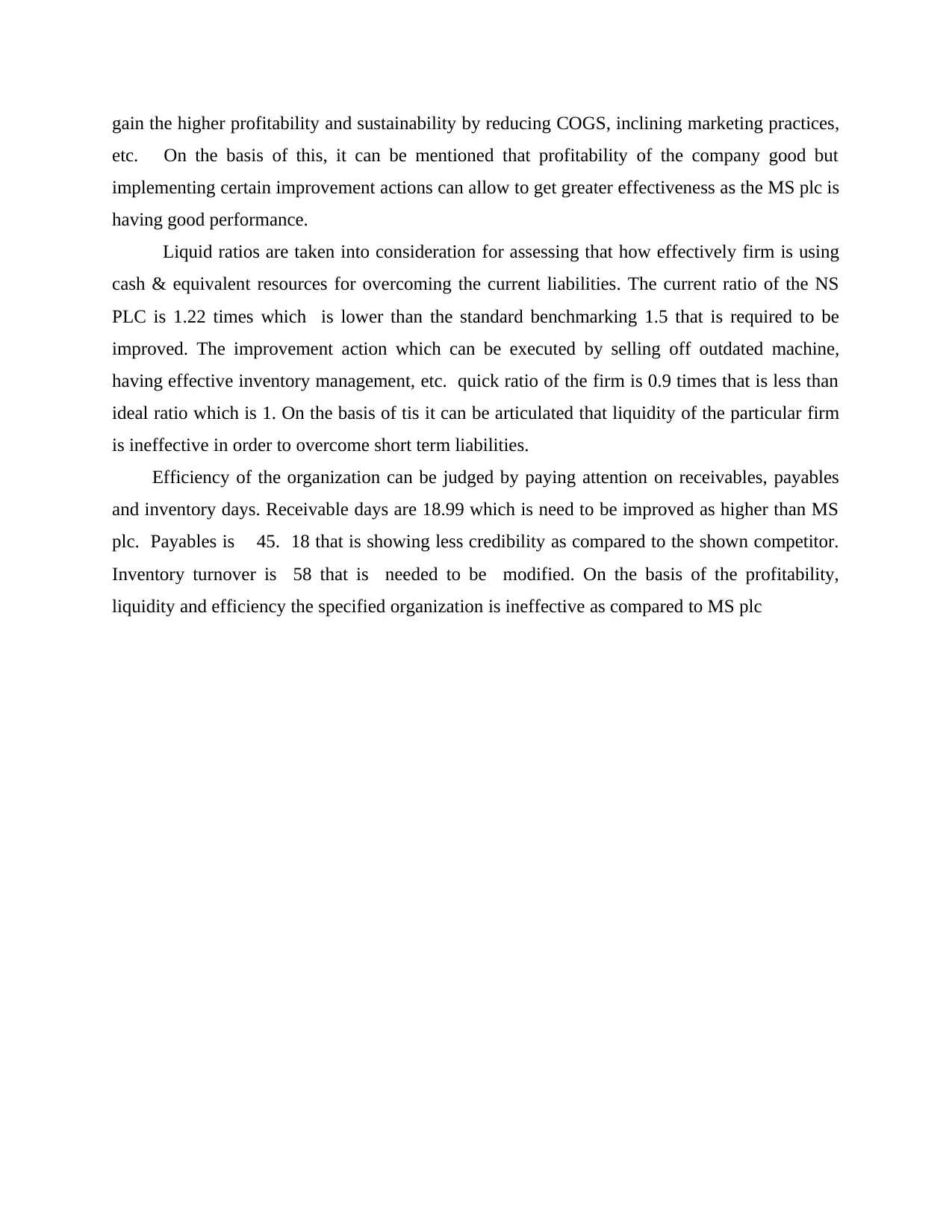
gain the higher profitability and sustainability by reducing COGS, inclining marketing practices,
etc. On the basis of this, it can be mentioned that profitability of the company good but
implementing certain improvement actions can allow to get greater effectiveness as the MS plc is
having good performance.
Liquid ratios are taken into consideration for assessing that how effectively firm is using
cash & equivalent resources for overcoming the current liabilities. The current ratio of the NS
PLC is 1.22 times which is lower than the standard benchmarking 1.5 that is required to be
improved. The improvement action which can be executed by selling off outdated machine,
having effective inventory management, etc. quick ratio of the firm is 0.9 times that is less than
ideal ratio which is 1. On the basis of tis it can be articulated that liquidity of the particular firm
is ineffective in order to overcome short term liabilities.
Efficiency of the organization can be judged by paying attention on receivables, payables
and inventory days. Receivable days are 18.99 which is need to be improved as higher than MS
plc. Payables is 45. 18 that is showing less credibility as compared to the shown competitor.
Inventory turnover is 58 that is needed to be modified. On the basis of the profitability,
liquidity and efficiency the specified organization is ineffective as compared to MS plc
etc. On the basis of this, it can be mentioned that profitability of the company good but
implementing certain improvement actions can allow to get greater effectiveness as the MS plc is
having good performance.
Liquid ratios are taken into consideration for assessing that how effectively firm is using
cash & equivalent resources for overcoming the current liabilities. The current ratio of the NS
PLC is 1.22 times which is lower than the standard benchmarking 1.5 that is required to be
improved. The improvement action which can be executed by selling off outdated machine,
having effective inventory management, etc. quick ratio of the firm is 0.9 times that is less than
ideal ratio which is 1. On the basis of tis it can be articulated that liquidity of the particular firm
is ineffective in order to overcome short term liabilities.
Efficiency of the organization can be judged by paying attention on receivables, payables
and inventory days. Receivable days are 18.99 which is need to be improved as higher than MS
plc. Payables is 45. 18 that is showing less credibility as compared to the shown competitor.
Inventory turnover is 58 that is needed to be modified. On the basis of the profitability,
liquidity and efficiency the specified organization is ineffective as compared to MS plc
Secure Best Marks with AI Grader
Need help grading? Try our AI Grader for instant feedback on your assignments.
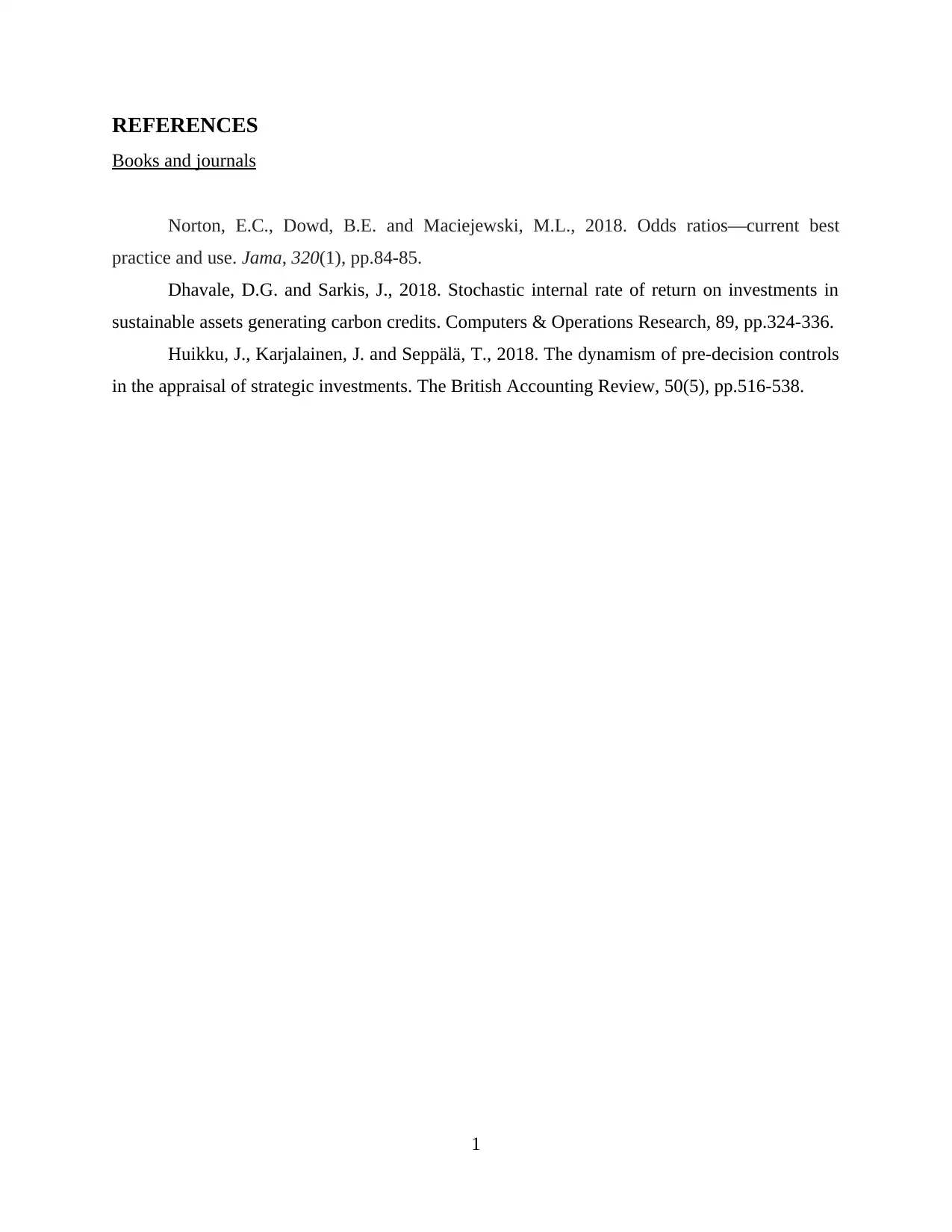
REFERENCES
Books and journals
Norton, E.C., Dowd, B.E. and Maciejewski, M.L., 2018. Odds ratios—current best
practice and use. Jama, 320(1), pp.84-85.
Dhavale, D.G. and Sarkis, J., 2018. Stochastic internal rate of return on investments in
sustainable assets generating carbon credits. Computers & Operations Research, 89, pp.324-336.
Huikku, J., Karjalainen, J. and Seppälä, T., 2018. The dynamism of pre-decision controls
in the appraisal of strategic investments. The British Accounting Review, 50(5), pp.516-538.
1
Books and journals
Norton, E.C., Dowd, B.E. and Maciejewski, M.L., 2018. Odds ratios—current best
practice and use. Jama, 320(1), pp.84-85.
Dhavale, D.G. and Sarkis, J., 2018. Stochastic internal rate of return on investments in
sustainable assets generating carbon credits. Computers & Operations Research, 89, pp.324-336.
Huikku, J., Karjalainen, J. and Seppälä, T., 2018. The dynamism of pre-decision controls
in the appraisal of strategic investments. The British Accounting Review, 50(5), pp.516-538.
1
1 out of 11
Related Documents
Your All-in-One AI-Powered Toolkit for Academic Success.
+13062052269
info@desklib.com
Available 24*7 on WhatsApp / Email
![[object Object]](/_next/static/media/star-bottom.7253800d.svg)
Unlock your academic potential
© 2024 | Zucol Services PVT LTD | All rights reserved.


